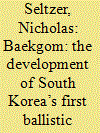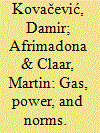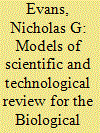|
|
|
Sort Order |
|
|
|
Items / Page
|
|
|
|
|
|
|
| Srl | Item |
| 1 |
ID:
169460


|
|
|
|
|
| Summary/Abstract |
This article traces and analyzes the development of South Korea’s first ballistic-missile system from 1971 through 1978 based on memoirs and personal accounts by scientists and officials directly involved in missile development during this time. The system is often described as a reverse-engineered copy of the Nike Hercules, a US surface-to-air missile, but this description does not capture the true character of South Korean missile development during the 1970s. By working on the Nike Hercules-based design in cooperation with American and French contractors, South Korea’s weapons specialists gained experience and built facilities that underpinned autonomous missile development for decades afterward. The accounts of South Korean weapons scientists also demonstrate that tacit knowledge—subtle or secret methods and tricks transmitted in person from mentors to protégés rather than written down in textbooks or manuals—can play a crucial role in building successful weapons programs and capable research-and-development capacities.
|
|
|
|
|
|
|
|
|
|
|
|
|
|
|
|
| 2 |
ID:
169455


|
|
|
|
|
| Summary/Abstract |
Nuclear disarmament is often seen as eventually requiring access to nuclear warheads or to the warhead-dismantlement process to verify that a state has not hidden weapons or weapon-materials despite promising to disarm. This article suggests this view is misplaced, and that what is needed is a verification mechanism able to provide reliable assurances of the absence of fissile materials available for use in weapons after a state has disarmed. Such a mechanism will need an initial declaration of the amount of fissile materials held by a state for all purposes, military and civilian. In a state with a nuclear arsenal awaiting elimination, this declaration would have to include materials that may not be available for verification because they are in nuclear weapons or are in other classified or proliferation-sensitive forms. This article describes a verification arrangement that does not require access to materials in weapons and in sensitive forms while still allowing checks on the overall accuracy of the declaration. Verification of the completeness and correctness of the declaration is deferred to the time when the weapons-relevant material enters the disposition process, at which point it no longer has any sensitive attributes. By removing the focus on monitoring warheads and dismantlement, this new approach could provide a more manageable path to nuclear disarmament.
|
|
|
|
|
|
|
|
|
|
|
|
|
|
|
|
| 3 |
ID:
169456


|
|
|
|
|
| Summary/Abstract |
Researchers have recently proposed a new approach to nuclear-arms-control verification, dubbed “deferred verification.” The concept forgoes inspections at sensitive nuclear sites and of nuclear weapons or components in classified form. To implement this concept, a state first divides its nuclear program into a closed segment and an open segment. The total fissile-material inventory in the closed segment, which includes the weapon complex, is known and declared with very high accuracy. Essentially no inspections take place in the closed segment. In contrast, inspectors have access to the open segment, which includes in particular the civilian nuclear sector. The fissile-material inventory in the open segment is known with less accuracy, but uncertainties can be reduced over time using nuclear-archaeology methods. Deferred verification relies primarily on established safeguards techniques and avoids many unresolved verification challenges, such as the need for information barriers for warhead confirmation measurements. At the same time, deferred verification faces some unique challenges. Here, we explore some of these challenges and offer possible solutions; to do so, we examine possible noncompliance strategies in which a state would seek to withhold a higher-than-declared inventory.
|
|
|
|
|
|
|
|
|
|
|
|
|
|
|
|
| 4 |
ID:
169459


|
|
|
|
|
| Summary/Abstract |
Whereas much of the debate about the demise of the 1987 Intermediate-range Nuclear Forces (INF) Treaty has focused on the European context and Russia’s alleged treaty violations, Asia looms large in the minds of proponents of the United States’s immediate withdrawal from the treaty. For many proponents, the fast-changing military balance in Asia and China's conventionally armed missiles constitute a sufficient cause for withdrawal. What does the end of the INF Treaty bode for the US-China military balance? This article argues that, although there are some near-term benefits for the US position in the conventional military balance with China, the advantages offered by prohibited missiles are minor and can be readily substituted by extant capabilities that are compliant with the treaty. Given the negative implications of the end of the INF Treaty for the future of arms control, the costs and benefits of withdrawing from the treaty require further examination; the military balance in Asia is an unpersuasive rationale for withdrawing from an important part of the arms-control architecture.
|
|
|
|
|
|
|
|
|
|
|
|
|
|
|
|
| 5 |
ID:
169458


|
|
|
|
|
| Summary/Abstract |
What restrains states from employing chemical weapons during modern war? Despite widespread and consistent efforts by the international community to outlaw chemical weapons in the twentieth century, major deviations from this goal occur. Two of the strongest explanations that exist for this trend are the logics of deterrence and norms that consider the use of chemical weapons to be a taboo. We test these theories using factor analysis and find that norms provide a better explanation of non-use in the twentieth century among states with a chemical-weapon capability. We then conclude with avenues for future research in this burgeoning field of study, which includes closer qualitative examination of norms, as well as the expansion of the dataset to include intrastate warfare and non-state warfare.
|
|
|
|
|
|
|
|
|
|
|
|
|
|
|
|
| 6 |
ID:
169463


|
|
|
|
|
| Summary/Abstract |
Science and technology (S&T) review is key to anticipating developments in the life sciences that may benefit or run contrary to the aims of the 1972 Biological and Toxin Weapons Convention. It serves as a mechanism for both preparing against novel biological threats and identifying the best opportunities for developing and sharing the life sciences to the fullest extent. In the age of rapidly advancing biotechnology, S&T review needs to be wide ranging, involve a diverse set of inputs, and be transparent about its methods and data. This viewpoint considers four models of S&T review and their capacity to respond to the challenge of the life sciences: standing advisory boards; ad hoc working groups; peer review; and wikis. It then identifies a hybrid model that is suitably broad, diverse, and transparent.
|
|
|
|
|
|
|
|
|
|
|
|
|
|
|
|
| 7 |
ID:
169461


|
|
|
|
|
| Summary/Abstract |
Despite living in a nuclear-weapon state, young Americans are generally ill-informed about weapons of mass destruction (WMD) and their means of control. The result is both widespread apathy toward nonproliferation and disarmament decision making among the general public and a looming personnel crisis within government sectors that enact policy in these domains. Considering that 67 percent of high school graduates in the United States go on to pursue a bachelor’s degree, exposing more undergraduates to nonproliferation and disarmament issues could contribute to addressing both of these challenges. The present study analyzes how these issues are already being taught at select US colleges and universities and explores ways to introduce them to more students that align with current priorities in higher education, such as interdisciplinary learning, digital humanities, and data-science learning. It also proposes concrete steps that the WMD policy community can take to help institutions of higher education integrate these topics more broadly into their curricula. The anticipated result is greater support for education in this important issue area across different stakeholders in academia, as well as increased engagement with these critical issues among a more diverse population of young people.
|
|
|
|
|
|
|
|
|
|
|
|
|
|
|
|
| 8 |
ID:
169457


|
|
|
|
|
| Summary/Abstract |
This article examines the centrality of uranium-enrichment centrifuges to the Brazilian nuclear program, arguing that these machines enabled the emergence of a technopolitical regime that invokes the trope of nuclear autonomy to advance policy and technological prescriptions. In order to understand the evolution of Brazil’s nuclear activities, the article addresses the dynamics within this technopolitical regime and its interactions with policy actors and other groups in society. This analysis is useful to identify aspects that have characterized Brazilian nuclear policy since the 1980s, such as: the promotion of self-regulation as the primary nonproliferation commitment, the crucial role played by the navy in the development of nuclear technology, the fluctuation of financial resources allocated to the nuclear program, and the difficulties of relying on public funds for a long-term technological project.
|
|
|
|
|
|
|
|
|
|
|
|
|
|
|
|
| 9 |
ID:
169462


|
|
|
|
|
| Summary/Abstract |
Beginning with UN Security Council Resolution 1718 in 2006, the international community has imposed a series of sanctions against North Korea in an effort to halt the progress of its nuclear program. These sanctions forbid most forms of the direct or indirect supply, sale, or transfer of arms, technical training, advice, services, or assistance, yet North Korea’s historical military and police cooperation with certain partner states has continued. In recent years, South Korea has targeted some of these states, including Uganda, with summit diplomacy, offers of security cooperation, and economic incentives to encourage them to distance themselves from North Korea. The case of Uganda illustrates some of the achievements and the challenges of international sanctions diplomacy.
|
|
|
|
|
|
|
|
|
|
|
|
|
|
|
|
|
|
|
|
|